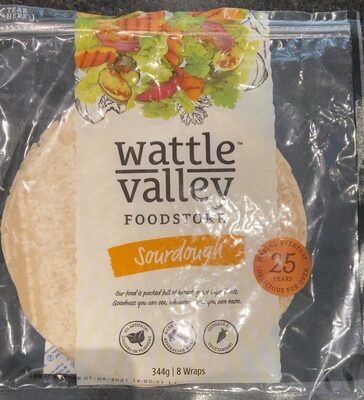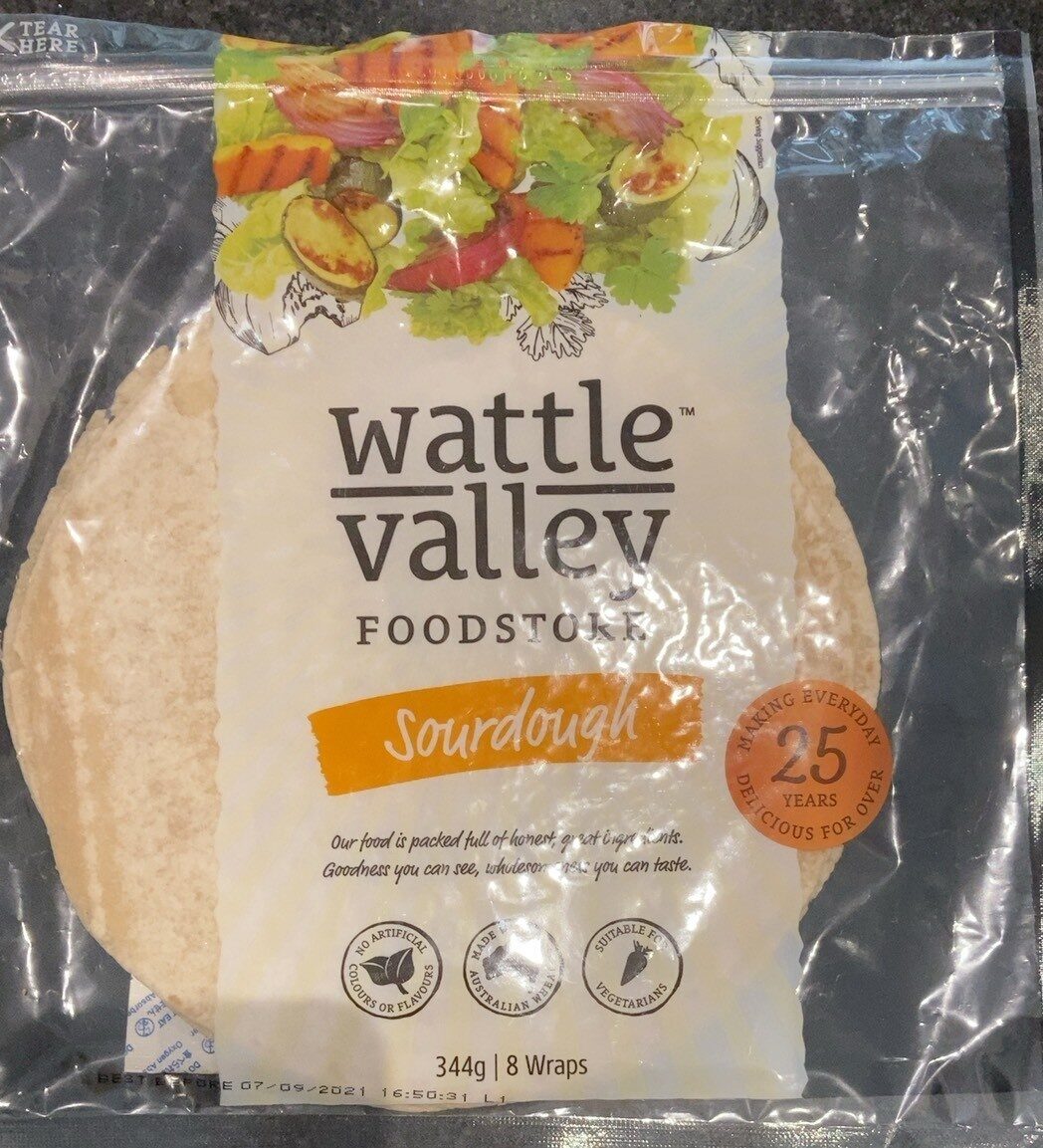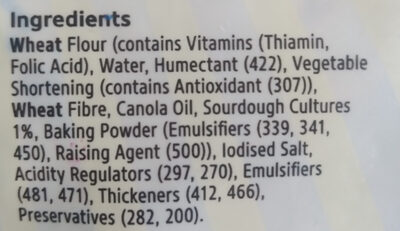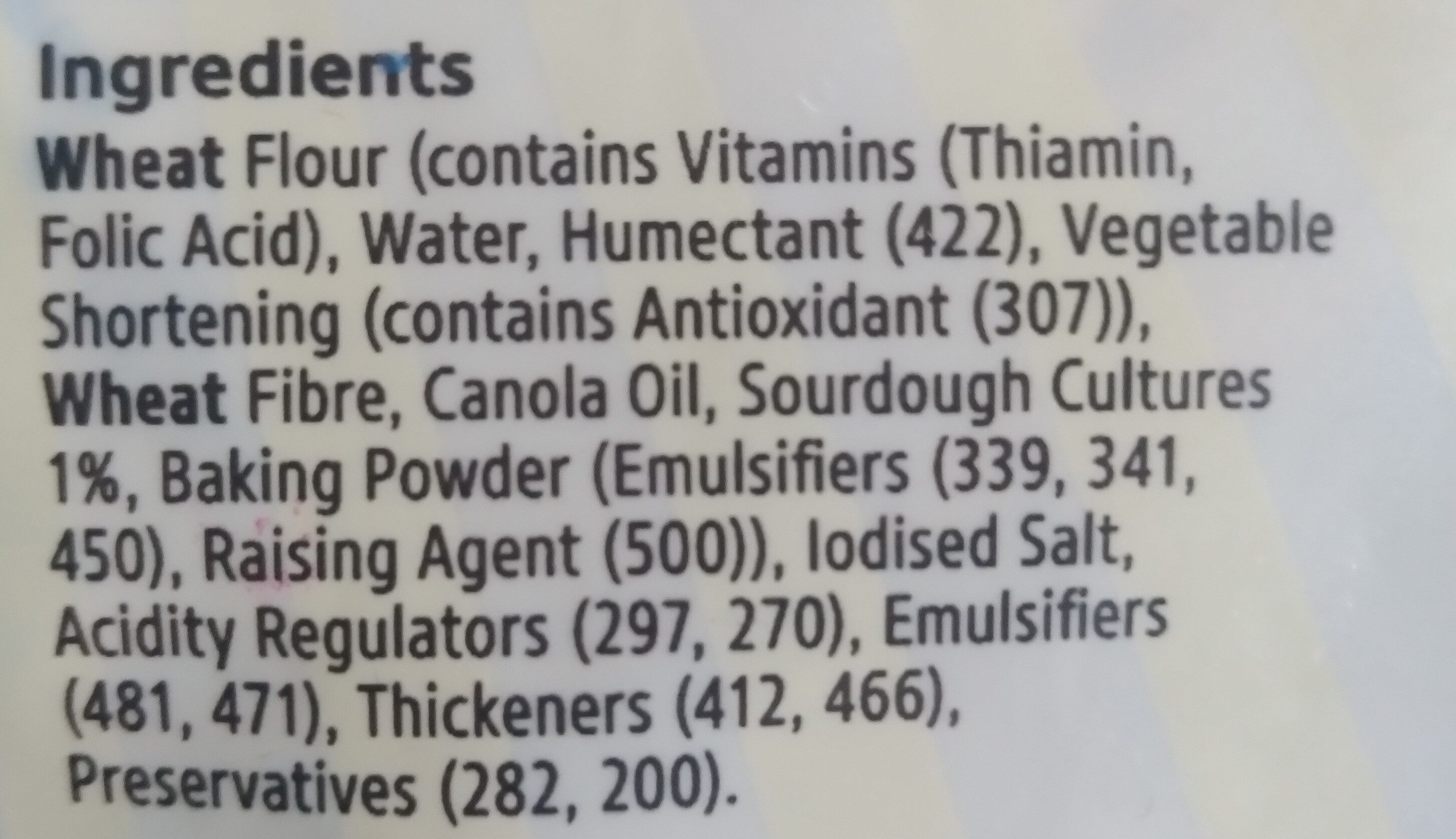Help us make food transparency the norm!
As a non-profit organization, we depend on your donations to continue informing consumers around the world about what they eat.
The food revolution starts with you!
Sourdough Wraps - Wattle Valley Foodstore
Sourdough Wraps - Wattle Valley Foodstore
This product page is not complete. You can help to complete it by editing it and adding more data from the photos we have, or by taking more photos using the app for Android or iPhone/iPad. Thank you!
×
Barcode: 9310288604618 (EAN / EAN-13)
Brands: Wattle Valley Foodstore
Categories: Plant-based foods and beverages, Plant-based foods, Cereals and potatoes, Breads, Flatbreads, White breads, Wheat breads, Wheat flatbreads
Countries where sold: Australia
Matching with your preferences
Health
Ingredients
-
33 ingredients
Wheat Flour (contains Vitamins (Thiamin, Folic Acid), Water, Humectant (422), Vegetable Shortening (contains Antioxidant (307)), Wheat Fibre, Canola Oil, Sourdough Cultures 1%, Baking Powder (Emulsifiers (339, 341, 450), Raising Agent (500)), lodised Salt, Acidity Regulators (297, 270), Emulsifiers (481, 471), Thickeners (412, 466), Preservatives (282, 200).Allergens: Gluten
Food processing
-
Ultra processed foods
Elements that indicate the product is in the 4 - Ultra processed food and drink products group:
- Additive: E412 - Guar gum
- Additive: E422 - Glycerol
- Additive: E450 - Diphosphates
- Additive: E466 - Sodium carboxy methyl cellulose
- Additive: E471 - Mono- and diglycerides of fatty acids
- Additive: E481 - Sodium stearoyl-2-lactylate
- Ingredient: Emulsifier
- Ingredient: Humectant
- Ingredient: Thickener
Food products are classified into 4 groups according to their degree of processing:
- Unprocessed or minimally processed foods
- Processed culinary ingredients
- Processed foods
- Ultra processed foods
The determination of the group is based on the category of the product and on the ingredients it contains.
Additives
-
E200 - Sorbic acid
Sorbic acid: Sorbic acid, or 2‚4-hexadienoic acid, is a natural organic compound used as a food preservative. It has the chemical formula CH3-CH-4CO2H. It is a colourless solid that is slightly soluble in water and sublimes readily. It was first isolated from the unripe berries of the Sorbus aucuparia -rowan tree-, hence its name.Source: Wikipedia
-
E270 - Lactic acid
Lactic acid: Lactic acid is an organic compound with the formula CH3CH-OH-COOH. In its solid state, it is white and water-soluble. In its liquid state, it is colorless. It is produced both naturally and synthetically. With a hydroxyl group adjacent to the carboxyl group, lactic acid is classified as an alpha-hydroxy acid -AHA-. In the form of its conjugate base called lactate, it plays a role in several biochemical processes. In solution, it can ionize a proton from the carboxyl group, producing the lactate ion CH3CH-OH-CO−2. Compared to acetic acid, its pKa is 1 unit less, meaning lactic acid deprotonates ten times more easily than acetic acid does. This higher acidity is the consequence of the intramolecular hydrogen bonding between the α-hydroxyl and the carboxylate group. Lactic acid is chiral, consisting of two optical isomers. One is known as L--+--lactic acid or -S--lactic acid and the other, its mirror image, is D--−--lactic acid or -R--lactic acid. A mixture of the two in equal amounts is called DL-lactic acid, or racemic lactic acid. Lactic acid is hygroscopic. DL-lactic acid is miscible with water and with ethanol above its melting point which is around 17 or 18 °C. D-lactic acid and L-lactic acid have a higher melting point. In animals, L-lactate is constantly produced from pyruvate via the enzyme lactate dehydrogenase -LDH- in a process of fermentation during normal metabolism and exercise. It does not increase in concentration until the rate of lactate production exceeds the rate of lactate removal, which is governed by a number of factors, including monocarboxylate transporters, concentration and isoform of LDH, and oxidative capacity of tissues. The concentration of blood lactate is usually 1–2 mM at rest, but can rise to over 20 mM during intense exertion and as high as 25 mM afterward. In addition to other biological roles, L-lactic acid is the primary endogenous agonist of hydroxycarboxylic acid receptor 1 -HCA1-, which is a Gi/o-coupled G protein-coupled receptor -GPCR-.In industry, lactic acid fermentation is performed by lactic acid bacteria, which convert simple carbohydrates such as glucose, sucrose, or galactose to lactic acid. These bacteria can also grow in the mouth; the acid they produce is responsible for the tooth decay known as caries. In medicine, lactate is one of the main components of lactated Ringer's solution and Hartmann's solution. These intravenous fluids consist of sodium and potassium cations along with lactate and chloride anions in solution with distilled water, generally in concentrations isotonic with human blood. It is most commonly used for fluid resuscitation after blood loss due to trauma, surgery, or burns.Source: Wikipedia
-
E282 - Calcium propionate
Calcium propanoate: Calcium propanoate or calcium propionate has the formula Ca-C2H5COO-2. It is the calcium salt of propanoic acid.Source: Wikipedia
-
E297 - Fumaric acid
Fumaric acid: Fumaric acid or trans-butenedioic acid is the chemical compound with the formula HO2CCH=CHCO2H. It is produced in eukaryotic organisms from succinate in complex 2 of the electron transport chain via the enzyme succinate dehydrogenase. It is one of two isomeric unsaturated dicarboxylic acids, the other being maleic acid. In fumaric acid the carboxylic acid groups are trans -E- and in maleic acid they are cis -Z-. Fumaric acid has a fruit-like taste. The salts and esters are known as fumarates. Fumarate can also refer to the C4H2O2−4 ion -in solution-.Source: Wikipedia
-
E307 - Alpha-tocopherol
Alpha-Tocopherol: α-Tocopherol is a type of vitamin E. It has E number "E307". Vitamin E exists in eight different forms, four tocopherols and four tocotrienols. All feature a chromane ring, with a hydroxyl group that can donate a hydrogen atom to reduce free radicals and a hydrophobic side chain which allows for penetration into biological membranes. Compared to the others, α-tocopherol is preferentially absorbed and accumulated in humans.Source: Wikipedia
-
E339 - Sodium phosphates
Sodium phosphates: Sodium phosphate is a generic term for a variety of salts of sodium -Na+- and phosphate -PO43−-. Phosphate also forms families or condensed anions including di-, tri-, tetra-, and polyphosphates. Most of these salts are known in both anhydrous -water-free- and hydrated forms. The hydrates are more common than the anhydrous forms.Source: Wikipedia
-
E341 - Calcium phosphates
Calcium phosphate: Calcium phosphate is a family of materials and minerals containing calcium ions -Ca2+- together with inorganic phosphate anions. Some so-called calcium phosphates contain oxide and hydroxide as well. They are white solids of nutritious value.Source: Wikipedia
-
E412 - Guar gum
Guar gum (E412) is a natural food additive derived from guar beans.
This white, odorless powder is valued for its remarkable thickening and stabilizing properties, making it a common ingredient in various food products, including sauces, dressings, and ice creams.
When used in moderation, guar gum is considered safe for consumption, with no known adverse health effects.
-
E422 - Glycerol
Glycerol: Glycerol -; also called glycerine or glycerin; see spelling differences- is a simple polyol compound. It is a colorless, odorless, viscous liquid that is sweet-tasting and non-toxic. The glycerol backbone is found in all lipids known as triglycerides. It is widely used in the food industry as a sweetener and humectant and in pharmaceutical formulations. Glycerol has three hydroxyl groups that are responsible for its solubility in water and its hygroscopic nature.Source: Wikipedia
-
E450 - Diphosphates
Diphosphates (E450) are food additives often utilized to modify the texture of products, acting as leavening agents in baking and preventing the coagulation of canned food.
These salts can stabilize whipped cream and are also found in powdered products to maintain their flow properties. They are commonly present in baked goods, processed meats, and soft drinks.
Derived from phosphoric acid, they're part of our daily phosphate intake, which often surpasses recommended levels due to the prevalence of phosphates in processed foods and drinks.
Excessive phosphate consumption is linked to health issues, such as impaired kidney function and weakened bone health. Though diphosphates are generally regarded as safe when consumed within established acceptable daily intakes, it's imperative to monitor overall phosphate consumption to maintain optimal health.
-
E466 - Sodium carboxy methyl cellulose
Carboxymethyl cellulose: Carboxymethyl cellulose -CMC- or cellulose gum or tylose powder is a cellulose derivative with carboxymethyl groups --CH2-COOH- bound to some of the hydroxyl groups of the glucopyranose monomers that make up the cellulose backbone. It is often used as its sodium salt, sodium carboxymethyl cellulose.Source: Wikipedia
-
E471 - Mono- and diglycerides of fatty acids
Mono- and diglycerides of fatty acids (E471), are food additives commonly used as emulsifiers in various processed foods.
These compounds consist of glycerol molecules linked to one or two fatty acid chains, which help stabilize and blend water and oil-based ingredients. E471 enhances the texture and shelf life of products like margarine, baked goods, and ice cream, ensuring a smooth and consistent texture.
It is generally considered safe for consumption within established regulatory limits.
-
E481 - Sodium stearoyl-2-lactylate
Sodium stearoyl lactylate: Sodium stearoyl-2-lactylate -sodium stearoyl lactylate or SSL- is a versatile, FDA approved food additive used to improve the mix tolerance and volume of processed foods. It is one type of a commercially available lactylate. SSL is non-toxic, biodegradable, and typically manufactured using biorenewable feedstocks. Because SSL is a safe and highly effective food additive, it is used in a wide variety of products ranging from baked goods and desserts to pet foods.As described by the Food Chemicals Codex 7th edition, SSL is a cream-colored powder or brittle solid. SSL is currently manufactured by the esterification of stearic acid with lactic acid and partially neutralized with either food-grade soda ash -sodium carbonate- or caustic soda -concentrated sodium hydroxide-. Commercial grade SSL is a mixture of sodium salts of stearoyl lactylic acids and minor proportions of other sodium salts of related acids. The HLB for SSL is 10-12. SSL is slightly hygroscopic, soluble in ethanol and in hot oil or fat, and dispersible in warm water. These properties are the reason that SSL is an excellent emulsifier for fat-in-water emulsions and can also function as a humectant.Source: Wikipedia
-
E500 - Sodium carbonates
Sodium carbonates (E500) are compounds commonly used in food preparation as leavening agents, helping baked goods rise by releasing carbon dioxide when they interact with acids.
Often found in baking soda, they regulate the pH of food, preventing it from becoming too acidic or too alkaline. In the culinary world, sodium carbonates can also enhance the texture and structure of foods, such as noodles, by modifying the gluten network.
Generally recognized as safe, sodium carbonates are non-toxic when consumed in typical amounts found in food.
Ingredients analysis
-
Palm oil content unknown
Unrecognized ingredients: 422, 307, 339, 341, 450, 500, Lodised-salt, 297, 270, 481, 471, 412, 466, 282, 200Some ingredients could not be recognized.
We need your help!
You can help us recognize more ingredients and better analyze the list of ingredients for this product and others:
- Edit this product page to correct spelling mistakes in the ingredients list, and/or to remove ingredients in other languages and sentences that are not related to the ingredients.
- Add new entries, synonyms or translations to our multilingual lists of ingredients, ingredient processing methods, and labels.
If you would like to help, join the #ingredients channel on our Slack discussion space and/or learn about ingredients analysis on our wiki. Thank you!
-
Vegan status unknown
Unrecognized ingredients: Thiamin, Folic acid, 422, 307, 339, 341, 450, 500, Lodised-salt, 297, 270, 481, 471, 412, 466, 282, 200Some ingredients could not be recognized.
We need your help!
You can help us recognize more ingredients and better analyze the list of ingredients for this product and others:
- Edit this product page to correct spelling mistakes in the ingredients list, and/or to remove ingredients in other languages and sentences that are not related to the ingredients.
- Add new entries, synonyms or translations to our multilingual lists of ingredients, ingredient processing methods, and labels.
If you would like to help, join the #ingredients channel on our Slack discussion space and/or learn about ingredients analysis on our wiki. Thank you!
-
Vegetarian status unknown
Unrecognized ingredients: Thiamin, Folic acid, 422, 307, 339, 341, 450, 500, Lodised-salt, 297, 270, 481, 471, 412, 466, 282, 200Some ingredients could not be recognized.
We need your help!
You can help us recognize more ingredients and better analyze the list of ingredients for this product and others:
- Edit this product page to correct spelling mistakes in the ingredients list, and/or to remove ingredients in other languages and sentences that are not related to the ingredients.
- Add new entries, synonyms or translations to our multilingual lists of ingredients, ingredient processing methods, and labels.
If you would like to help, join the #ingredients channel on our Slack discussion space and/or learn about ingredients analysis on our wiki. Thank you!
-
Details of the analysis of the ingredients
We need your help!
Some ingredients could not be recognized.
We need your help!
You can help us recognize more ingredients and better analyze the list of ingredients for this product and others:
- Edit this product page to correct spelling mistakes in the ingredients list, and/or to remove ingredients in other languages and sentences that are not related to the ingredients.
- Add new entries, synonyms or translations to our multilingual lists of ingredients, ingredient processing methods, and labels.
If you would like to help, join the #ingredients channel on our Slack discussion space and/or learn about ingredients analysis on our wiki. Thank you!
en: Wheat Flour, contains vitamins, Thiamin, Folic Acid, Water, Humectant (422), Vegetable Shortening (contains Antioxidant (307)), Wheat Fibre, Canola Oil, Sourdough Cultures 1%, Baking Powder (Emulsifiers (339, 341, 450), Raising Agent (500)), lodised Salt, Acidity Regulators (297, 270), Emulsifiers (481, 471), Thickeners (412, 466), Preservatives (282, 200)- Wheat Flour -> en:wheat-flour - vegan: yes - vegetarian: yes - ciqual_proxy_food_code: 9410 - percent_min: 6.25 - percent_max: 91
- contains vitamins -> en:vitamins - vegan: yes - vegetarian: yes - percent_min: 1 - percent_max: 46
- Thiamin -> en:thiamin - percent_min: 1 - percent_max: 31
- Folic Acid -> en:folic-acid - percent_min: 1 - percent_max: 23.5
- Water -> en:water - vegan: yes - vegetarian: yes - ciqual_food_code: 18066 - percent_min: 1 - percent_max: 19
- Humectant -> en:humectant - percent_min: 1 - percent_max: 16
- 422 -> en:422 - percent_min: 1 - percent_max: 16
- Vegetable Shortening -> en:vegetable-fat - vegan: yes - vegetarian: yes - from_palm_oil: maybe - percent_min: 1 - percent_max: 13.8571428571429
- contains Antioxidant -> en:antioxidant - percent_min: 1 - percent_max: 13.8571428571429
- 307 -> en:307 - percent_min: 1 - percent_max: 13.8571428571429
- contains Antioxidant -> en:antioxidant - percent_min: 1 - percent_max: 13.8571428571429
- Wheat Fibre -> en:wheat-fiber - vegan: yes - vegetarian: yes - percent_min: 1 - percent_max: 12.25
- Canola Oil -> en:canola-oil - vegan: yes - vegetarian: yes - from_palm_oil: no - ciqual_food_code: 17130 - percent_min: 1 - percent_max: 11
- Sourdough Cultures -> en:sourdough-starter - vegan: maybe - vegetarian: yes - percent_min: 1 - percent: 1 - percent_max: 1
- Baking Powder -> en:baking-powder - vegan: yes - vegetarian: yes - ciqual_food_code: 11046 - percent_min: 0 - percent_max: 1
- Emulsifiers -> en:emulsifier - percent_min: 0 - percent_max: 1
- 339 -> en:339 - percent_min: 0 - percent_max: 1
- 341 -> en:341 - percent_min: 0 - percent_max: 0.5
- 450 -> en:450 - percent_min: 0 - percent_max: 0.333333333333333
- Raising Agent -> en:raising-agent - percent_min: 0 - percent_max: 0.5
- 500 -> en:500 - percent_min: 0 - percent_max: 0.5
- Emulsifiers -> en:emulsifier - percent_min: 0 - percent_max: 1
- lodised Salt -> en:lodised-salt - percent_min: 0 - percent_max: 1
- Acidity Regulators -> en:acidity-regulator - percent_min: 0 - percent_max: 1
- 297 -> en:297 - percent_min: 0 - percent_max: 1
- 270 -> en:270 - percent_min: 0 - percent_max: 0.5
- Emulsifiers -> en:emulsifier - percent_min: 0 - percent_max: 1
- 481 -> en:481 - percent_min: 0 - percent_max: 1
- 471 -> en:471 - percent_min: 0 - percent_max: 0.5
- Thickeners -> en:thickener - percent_min: 0 - percent_max: 1
- 412 -> en:412 - percent_min: 0 - percent_max: 1
- 466 -> en:466 - percent_min: 0 - percent_max: 0.5
- Preservatives -> en:preservative - percent_min: 0 - percent_max: 1
- 282 -> en:282 - percent_min: 0 - percent_max: 1
- 200 -> en:200 - percent_min: 0 - percent_max: 0.5
Nutrition
-
Good nutritional quality
⚠ ️Warning: the amount of fruits, vegetables and nuts is not specified on the label, it was estimated from the list of ingredients: 0This product is not considered a beverage for the calculation of the Nutri-Score.
Positive points: 9
- Proteins: 4 / 5 (value: 6.7, rounded value: 6.7)
- Fiber: 5 / 5 (value: 5.7, rounded value: 5.7)
- Fruits, vegetables, nuts, and colza/walnut/olive oils: 0 / 5 (value: 0.2255859375, rounded value: 0.2)
Negative points: 10
- Energy: 3 / 10 (value: 1200, rounded value: 1200)
- Sugars: 0 / 10 (value: 1.2, rounded value: 1.2)
- Saturated fat: 2 / 10 (value: 2.5, rounded value: 2.5)
- Sodium: 5 / 10 (value: 475, rounded value: 475)
The points for proteins are counted because the negative points are less than 11.
Nutritional score: (10 - 9)
Nutri-Score:
-
Nutrient levels
-
Fat in moderate quantity (6%)
What you need to know- A high consumption of fat, especially saturated fats, can raise cholesterol, which increases the risk of heart diseases.
Recommendation: Limit the consumption of fat and saturated fat- Choose products with lower fat and saturated fat content.
-
Saturated fat in moderate quantity (2.5%)
What you need to know- A high consumption of fat, especially saturated fats, can raise cholesterol, which increases the risk of heart diseases.
Recommendation: Limit the consumption of fat and saturated fat- Choose products with lower fat and saturated fat content.
-
Sugars in low quantity (1.2%)
What you need to know- A high consumption of sugar can cause weight gain and tooth decay. It also augments the risk of type 2 diabetes and cardio-vascular diseases.
Recommendation: Limit the consumption of sugar and sugary drinks- Sugary drinks (such as sodas, fruit beverages, and fruit juices and nectars) should be limited as much as possible (no more than 1 glass a day).
- Choose products with lower sugar content and reduce the consumption of products with added sugars.
-
Salt in moderate quantity (1.19%)
What you need to know- A high consumption of salt (or sodium) can cause raised blood pressure, which can increase the risk of heart disease and stroke.
- Many people who have high blood pressure do not know it, as there are often no symptoms.
- Most people consume too much salt (on average 9 to 12 grams per day), around twice the recommended maximum level of intake.
Recommendation: Limit the consumption of salt and salted food- Reduce the quantity of salt used when cooking, and don't salt again at the table.
- Limit the consumption of salty snacks and choose products with lower salt content.
-
-
Nutrition facts
Nutrition facts As sold
for 100 g / 100 mlAs sold
per serving (43g)Compared to: Wheat flatbreads Energy 1,200 kj
(287 kcal)516 kj
(123 kcal)-6% Fat 6 g 2.58 g -16% Saturated fat 2.5 g 1.07 g +17% Carbohydrates 48 g 20.6 g +5% Sugars 1.2 g 0.516 g -32% Fiber 5.7 g 2.45 g +39% Proteins 6.7 g 2.88 g -23% Salt 1.188 g 0.511 g +19% Fruits‚ vegetables‚ nuts and rapeseed‚ walnut and olive oils (estimate from ingredients list analysis) 0.226 % 0.226 %
Environment
-
Eco-Score B - Low environmental impact
⚠ ️The full impact of transportation to your country is currently unknown.The Eco-Score is an experimental score that summarizes the environmental impacts of food products.→ The Eco-Score was initially developped for France and it is being extended to other European countries. The Eco-Score formula is subject to change as it is regularly improved to make it more precise and better suited to each country.Life cycle analysis
-
Average impact of products of the same category: A (Score: 93/100)
Category: Wheat tortilla wrap, to be filled
Category: Wheat tortilla wrap, to be filled
- PEF environmental score: 0.16 (the lower the score, the lower the impact)
- including impact on climate change: 1.13 kg CO2 eq/kg of product
Stage Impact Agriculture
42.7 %Processing
35.0 %Packaging
15.0 %Transportation
6.8 %Distribution
0.5 %Consumption
0.0 %
Bonuses and maluses
-
Missing origins of ingredients information
Malus:
⚠ ️ The origins of the ingredients of this product are not indicated.
If they are indicated on the packaging, you can modify the product sheet and add them.
If you are the manufacturer of this product, you can send us the information with our free platform for producers.
-
Packaging with a medium impact
Malus: -10
Shape Material Recycling Impact Bag Plastic High
Eco-Score for this product
-
Impact for this product: B (Score: 78/100)
Product: Sourdough Wraps - Wattle Valley Foodstore
Life cycle analysis score: 93
Sum of bonuses and maluses: -10
Final score: 78/100
-
Carbon footprint
-
Equal to driving 0.6 km in a petrol car
113 g CO² per 100g of product
The carbon emission figure comes from ADEME's Agribalyse database, for the category: Wheat tortilla wrap, to be filled (Source: ADEME Agribalyse Database)
Stage Impact Agriculture
35.5 %Processing
27.7 %Packaging
24.8 %Transportation
11.6 %Distribution
0.4 %Consumption
0.0 %
Packaging
-
Packaging with a medium impact
-
Packaging parts
Bag (Plastic)
-
Packaging materials
Material % Packaging weight Plastic
-
Transportation
-
Origins of ingredients
Missing origins of ingredients information
⚠ ️ The origins of the ingredients of this product are not indicated.
If they are indicated on the packaging, you can modify the product sheet and add them.
If you are the manufacturer of this product, you can send us the information with our free platform for producers.Add the origins of ingredients for this product Add the origins of ingredients for this product
Report a problem
-
Incomplete or incorrect information?
Category, labels, ingredients, allergens, nutritional information, photos etc.
If the information does not match the information on the packaging, please complete or correct it. Open Food Facts is a collaborative database, and every contribution is useful for all.
Data sources
Product added on by kiliweb
Last edit of product page on by gisele67.
Product page also edited by clockwerx, ecoscore-impact-estimator, openfoodfacts-contributors, packbot, yuka.sY2b0xO6T85zoF3NwEKvllFVTMOCqxHBMy3VuUqJ_uuKALXBZd18u4PeGqo.










